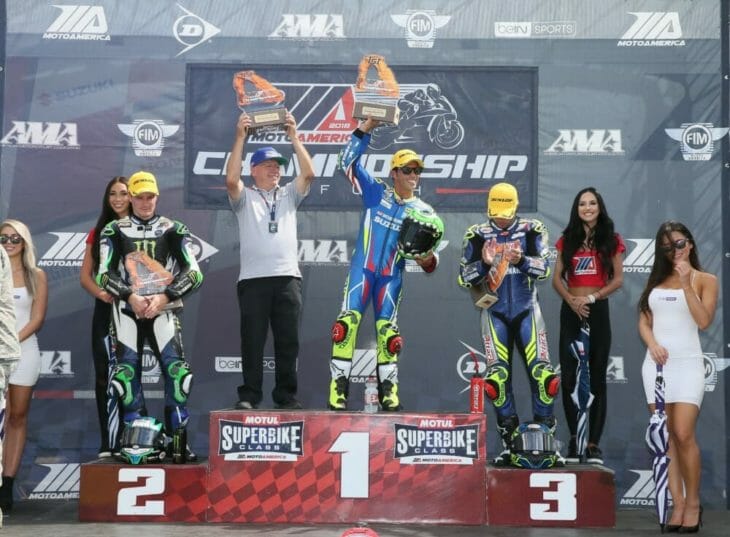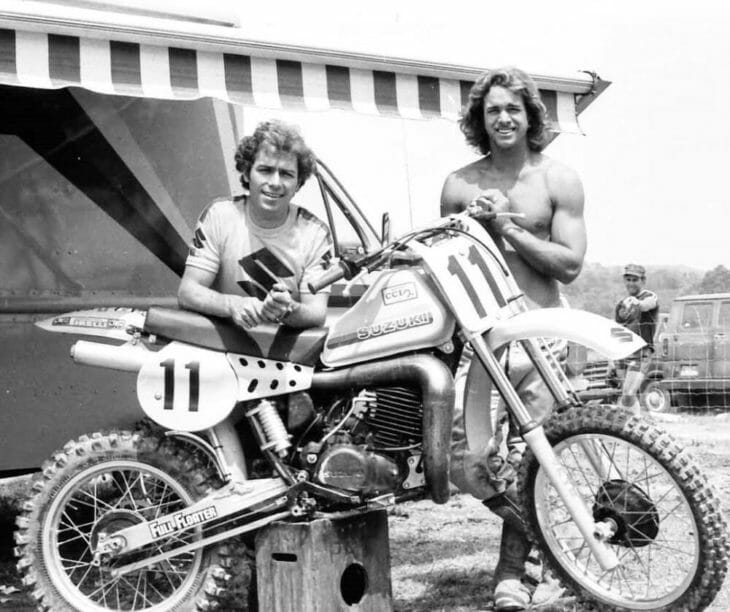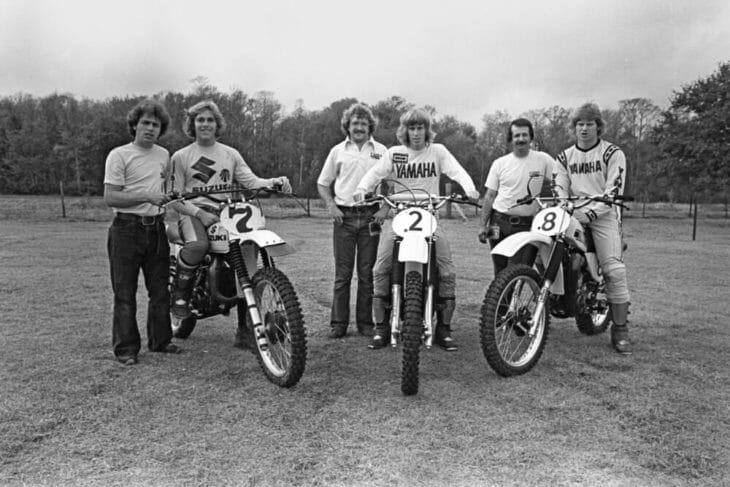Larry Lawrence | March 17, 2020
Cycle News Archives
COLUMN
The Man Who’s Seen It All
There aren’t many people in America’s motorcycle racing paddocks today who can boast of being part of seven decades of the sport. Pat Alexander is one such person. From his earliest days of motocross racing in the late-1960s, to managing Suzuki’s racing programs today, Alexander’s life in motorcycling has been intertwined with many of the legends of racing. A humble man who finds it difficult to talk about his own career, Alexander’s track record of being a part of successful racing programs is nearly unmatched.
 Pat Alexander (gray shirt), alongside his rider Toni Elias, after Elias won at Utah in 2018 giving Suzuki its 200th AMA Superbike victory. Photo by Brian J. Nelson
Pat Alexander (gray shirt), alongside his rider Toni Elias, after Elias won at Utah in 2018 giving Suzuki its 200th AMA Superbike victory. Photo by Brian J. Nelson
Alexander grew up in Southern California in the 1960s and began racing motocross as a kid. His first machine was a Suzuki TC120.
“I rode that until it broke into little bitty pieces,” Alexander laughs. “It had a pressed frame and riding at Saddleback it didn’t last long. Then a friend of mine at school offered to let me buy this CZ, so that was my first true motocross bike.”
Motocross was becoming so popular in the late ‘60s to early ‘70s, that Alexander said you could race four or five nights a week and he often did. “It was a crazy and fun time to be a part of the sport when it was just getting going,” Alexander added.
But then Alexander got hurt racing and was laid up for a while and then he came back and briefly got into boat racing. It was a school buddy named Mark Tyer that pulled him back into motocross.
“He was turning professional and he coaxed me back into helping him do some nationals over a month’s time,” Alexander remembers. “So I took a sabbatical at work, a toolbox, 300 dollars, a sleeping bag and was on my way.”
Alexander’s summer trip with Tyer included a trip to the 125cc USGP at Mid-Ohio, where Tyer’s claim to fame was nailing the holeshot in one of the motos.
“We drove a 1963 Helms Bakery bread truck,” Alexander grins when he recalls his first big motocross excursion. “Originally it was supposed to be three guys and then Mark dragged me along, so it was four guys and they had three bunk beds, so somebody had to sleep outside. We flipped for that.”
Alexander loved being on the circuit so much, he quit his day job and not long after signed on as a mechanic for the burgeoning DG Racing squad. According to Alexander, DG Racing had an interesting deal where they ran Pro-Fab frames and then would use whatever manufacturer’s engine they wanted. So, for example, Broc Glover was on the DG team running Honda CR motors, while Alexander’s rider Dave Taylor was running Yamaha YZ-powered machines.
 One of the riders Pat Alexander (left) worked with was multi-time MX champ Marty Smith (right). (Tom Mueller photo)
One of the riders Pat Alexander (left) worked with was multi-time MX champ Marty Smith (right). (Tom Mueller photo)
While the competition on the track could be intense, Alexander says the motocross circus back then was very much one of friendly camaraderie and people helping one another. Even in the days of works bikes it would be hard to keep secrets because the traveling mechanics were all such good friends.
“We’d be in the hotel parking lots working on the bikes with a bunch of the other teams,” Alexander recalls. “And we’d all talk back and forth and find out what each other was doing to their bikes. It was really pleasant and a lot of fun.”
The biggest issue in those early two-stroke days was trying to keep the bikes from seizing.
“The gas we were using, we didn’t know,” Alexander says. “We were mixing av [aviation] with regular gas to try to come up with a combination that would be reasonable. It was kind of rudimentary. We didn’t have anyway to test fuel and we were getting regular gas from gas stations.”
In January of 1977 Alexander was hired by Suzuki. His first task with Suzuki’s racing team was an eye opener.
“My first week there, I was just a young kid who just showed up and they told me to go crush a bunch of factory engines and Ollie Petersen’s beautiful RH works bike, that he’d never even ridden. That was my introduction to Suzuki. I was heartbroken, but that’s what all the factories did in those days.”
It was a time of unobtainable works machinery in motocross coming directly from the factory. At some points the deadlines were so tight, the team might first see the bike when they arrived for a race and picked it up from an airport.
“That’s why they called them works bikes, because we always worked on them,” Alexander only halfway jokes, before adding that when they got a works machine from the factory it was like kids gathering around the tree on Christmas morning.
“I almost don’t know how to explain it,” he says. “We were in such awe of what the Japanese created for us to go race with. It was just a beautiful thing.”
Alexander was Danny LaPorte’s mechanic in 1977, when LaPorte would have won the AMA 125cc Motocross Championship except for the infamous “Let Broc Bye” incident where Yamaha ordered Bob Hannah to allow Broc Glover to pass him on the final lap at the series finale, so Glover (and Yamaha) could win the title.
During his days as a Suzuki motocross racing mechanic, Alexander, along with fellow mechanic Chris Haines, developed a chain guide that eventually found its way to the production Suzukis.
In 1982 was made manager of Suzuki’s motocross team. In 1986 came the end of the works era in motocross. Alexander remembers it as a sad time.
 One of Pat Alexander’s first jobs with Suzuki was wrenching for Danny LaPorte, shown here with the 1978 Florida Winter-AMA Series Champions. From Left: 125cc (7) Danny LaPorte / Suzuki RA 125 with Alexander, 250cc (2) Bob Hannah / YZ 250 with Keith McCarty, Open (8) Rick Burgett / Yamaha YZ400 with Larry Carpenter. (Photo ©Jim Gianatsis /)
One of Pat Alexander’s first jobs with Suzuki was wrenching for Danny LaPorte, shown here with the 1978 Florida Winter-AMA Series Champions. From Left: 125cc (7) Danny LaPorte / Suzuki RA 125 with Alexander, 250cc (2) Bob Hannah / YZ 250 with Keith McCarty, Open (8) Rick Burgett / Yamaha YZ400 with Larry Carpenter. (Photo ©Jim Gianatsis /)
“We were devastated,” he says of no longer experiencing the annual thrill of getting the trick machines from Japan. “We had to re-engage with production bikes. It was difficult for Suzuki because we had such long success with works bikes. It was a learning experience. The thing about that era is, the stuff we used on the works bikes usually made it to production bikes two to four years later.”
Suzuki then pegged Alexander to help build its amateur and support racing programs in the 1990s. He became involved with Suzuki’s road racing efforts in 2000, just as Yoshimura Suzuki was entering a period of domination in AMA Superbike with Mat Mladin and Ben Spies. “I kind of rode on some people’s coattails on that one,” he adds with a grin.
Alexander loves so many things about his job with Suzuki, the one thing he admits finding tough is trying not to become too close to the riders. You could see the emotion in Alexander’s eyes when talking about this.
“As hard as it is, I tend to try to keep a little distance in my relationships with our riders,” Alexander admits. “If something happens and our contracts didn’t work out, I didn’t want to hurt my heart. You hire these guys, sometimes giving them their start, and you work so closely with them and sometimes when they go it tears you up.”
Parting ways with guys you’ve gone into battle with is always one the cruelest parts of racing.
And talk with the riders Alexander has worked with over the years and you can tell the admiration is mutual. Case in point: When Roger Hayden retired from road racing, he made a point of mentioning Alexander, along with Yoshimura Suzuki’s Don Sakakura, to the media. “Don and Pat are more like friends to me than a boss. We talk about life, sports, you name it, and it’s just been a pleasure to be part of the team.”
It’s been 43 years and counting at Suzuki for Alexander and he’s still going strong, working every day to help his teams and riders reach their full potential.